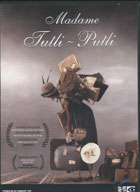
Madame Tutli-Putli 2007
Distributed by National Film Board of Canada, 1123 Broadway, Suite 307, New York, NY 10010; 800-542-2164
Produced by David Verrall, Marcy Page
Directed by Chris Lavis, Maciek Szczerbowski
DVD, color, 18 min.
Sr. High - Adult
Film Studies
Date Entered: 02/07/2008
Reviewed by Dan DiLandro, E.H. Butler Library, State University of New York College at BuffaloMadame Tutli-Pulti is a stop-motion animated masterpiece. A winner of several awards, the artistic quality of the film cannot be underestimated; indeed, this short film is said to have taken several years for the filmmakers to complete. The artistry shows; but in terms of educational library collections, Madame Tutli-Pulti must be viewed with some reservations.
The film presents a tired, drawn, and haggard central character, initially surrounded by a huge collections of personal belongings (one is tempted to say “absurdly huge collection,” though it is clear that Tutli-Putli’s belongings are no different from the “baggage” we all attract), waiting to board a train. The protagonist’s ride is truly unpleasant: the other passengers are at least menacing, if not downright and overtly violent. For example, Mme. Tutli-Putli’s game playing cabin-mates play an absurd game of chess, based upon the random placements of game pieces as dictated by the bumping, jostling train; a creepily-portrayed child across from her is shown reading a book entitled “How to Handle Your Enemies”; and a tennis player opposite her leers at her menacingly.
The short film is reminiscent to this point, perhaps, of Hitchcock’s The Lady Vanishes—but there is increasingly little whimsy here, and a much greater sense of menace. The film depicts disturbing individuals hanging from the train’s wires and lines, and the train itself is stopped—to a menacing, though beautifully classical music-type score—in the middle of a dark forest.
Madame Tutli-Pulti becomes truly suspenseful, including a gassing of the train’s passengers (presented, as always, with beautiful and perfect artistry), and a what-may-not-be-real vision of the heroine’s hazily watching the wolfish tennis player’s kidney being cut out!
Subsequently, Mme. Tutli-Pulti runs through the train, escaping into night under ambivalent circumstances.
That synopsis offered, it is essential to note the real artistry of the film. Associated promotional material speaks of this film’s “existentialism”—and such a theory will provided older film students and adults with a fine opportunity to discuss the nature of existentialism, suspense, horror, as well as the perhaps equivocal ending. But –and this cannot be emphasized enough—Madame Tutli-Pulti is a film exceptionally worthy of study by filmmakers or student and adult philosophers. The film is not for children, regardless of its animated construction: children will certainly be uncomfortable with viewing a terrified-looking (though surely realistic) puppet tormented on a claustrophobic train. Truly fantastically made, truly worthy of study for its art, content, and the questions the film asks—Madame Tutli-Pulti is highly recommended especially for older student or adult audiences interested in the art and impact of filmmaking.
Awards
- Canal+ Award for Best Short Film, Petit Rail d’Or for Best Short Film, International Critics Week, Cannes, 2007
- Best Animation, First Place, Palm Springs International Shortfest, 2007
- Nominated for Best Short Film (Animated) by the Academy of Motion Picture Arts and Sciences 2008